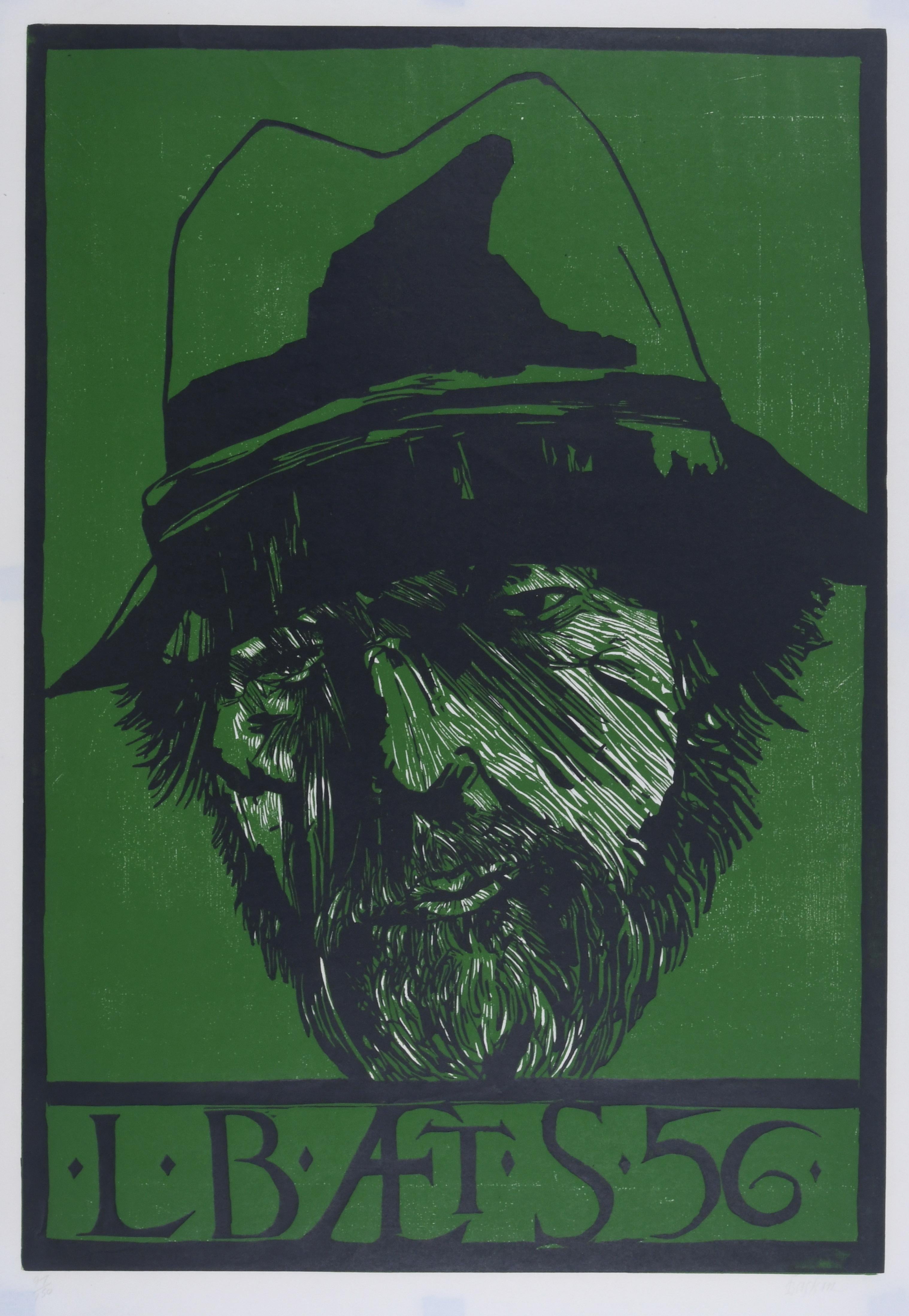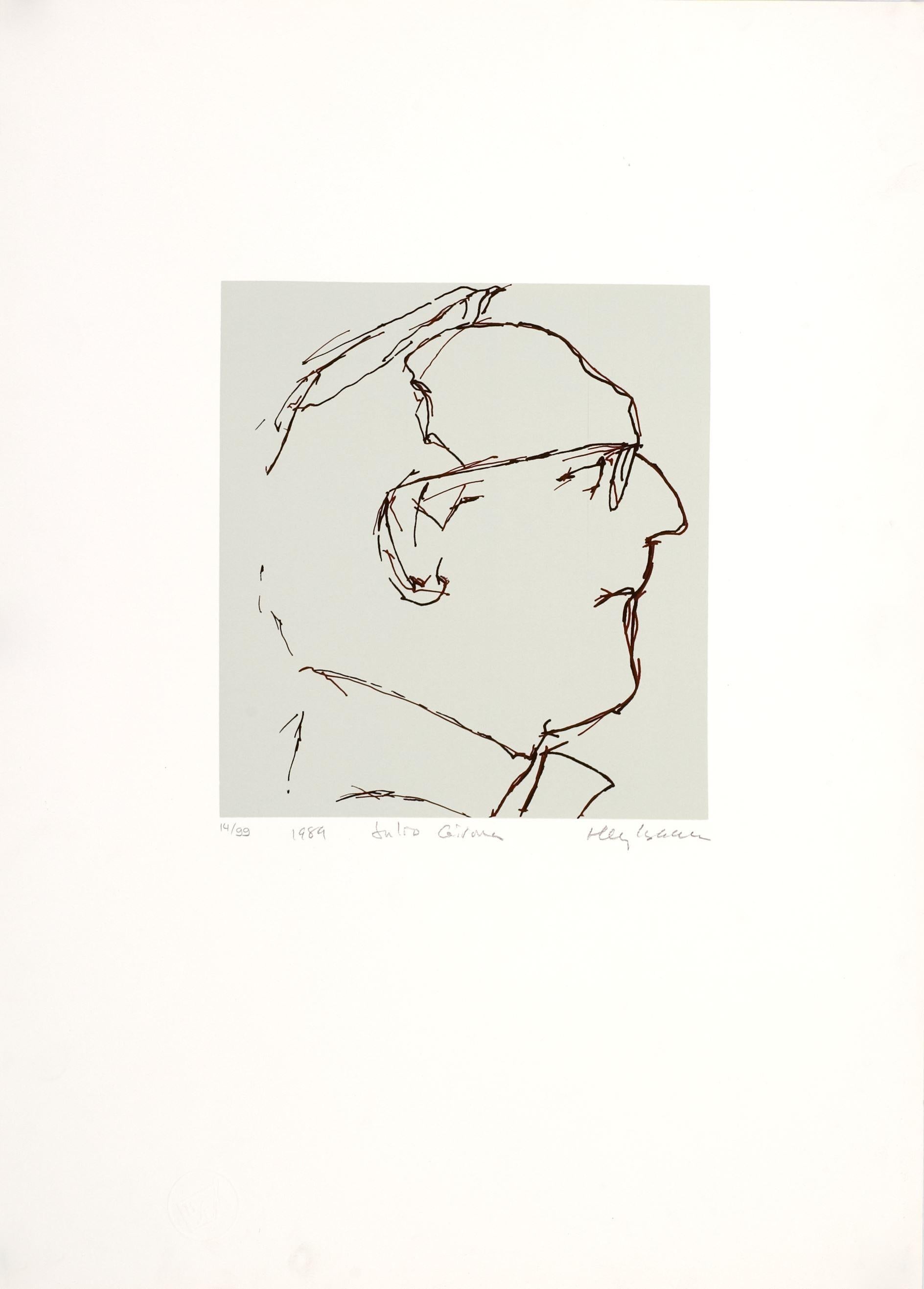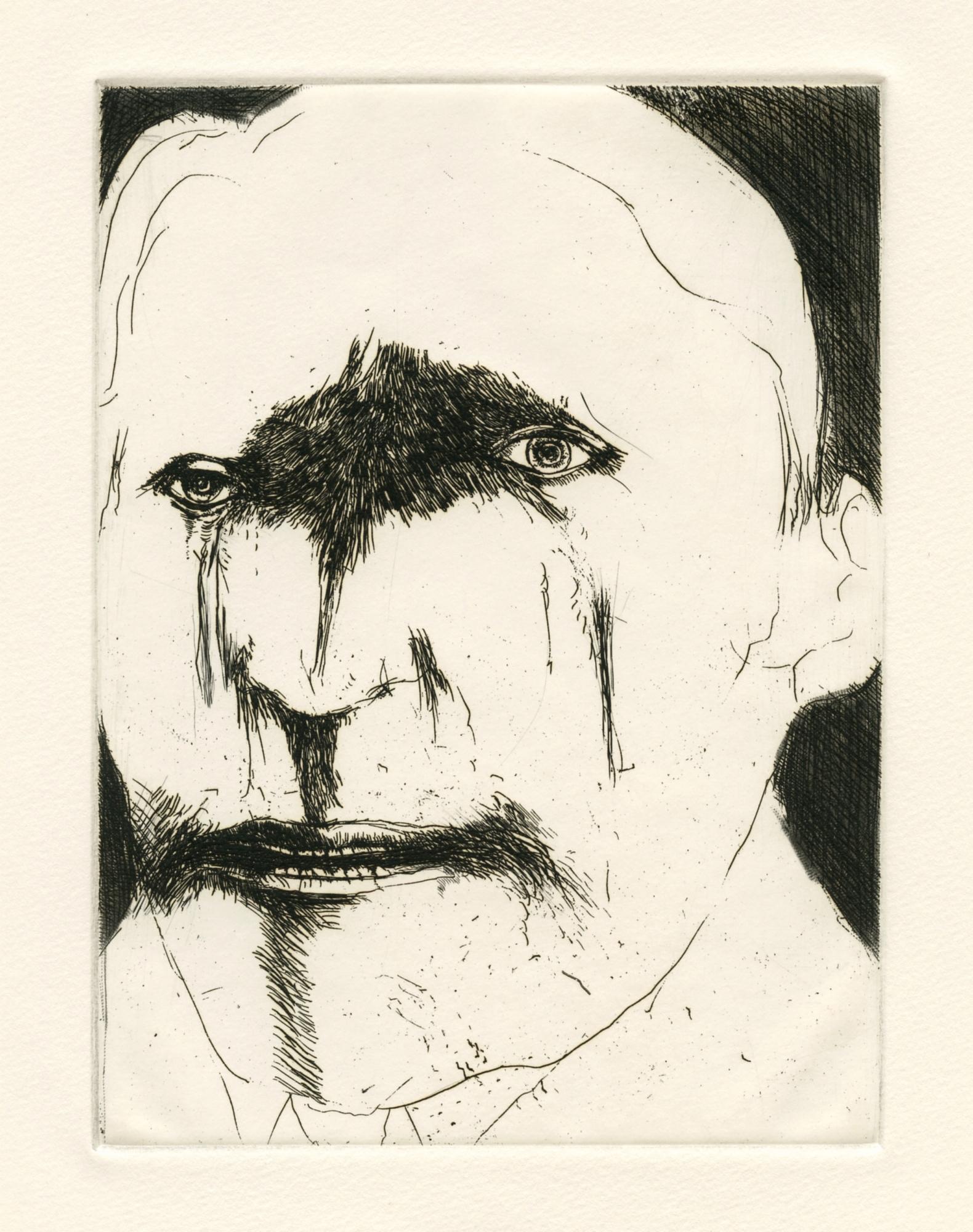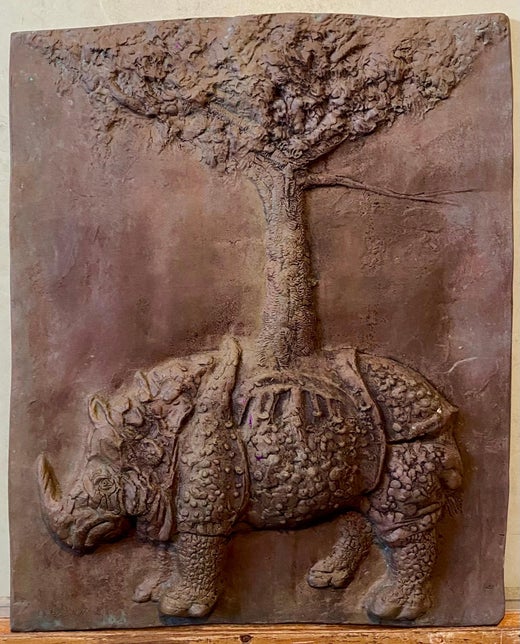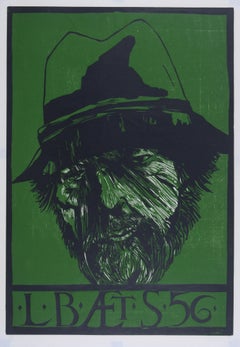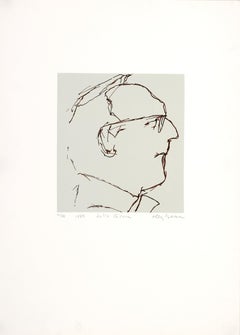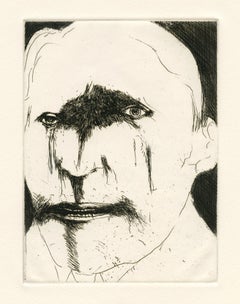Want more images or videos?
Request additional images or videos from the seller
1 of 10
Leonard BaskinAmos1960
1960
$950
£736.43
€833.58
CA$1,359.65
A$1,483.68
CHF 770.12
MX$17,751.01
NOK 9,775.27
SEK 9,156.37
DKK 6,226.60
About the Item
This artwork titled "Amos" 1960 is an original woodcut on paper by noted American artist Leonard Baskin, 1922-2000. It is hand signed, titled and numbered 35/50in pencil by the artist. The block mark (image) size is 15 x 16.85 inches, framed size is 23 x 27 inches. Custom framed in a wooden silver frame, with off-white matting. The artwork, plexiglass and matting is in excellent condition, the frame have some restorations, it will be a good idea to have it replaced. This particular artwork is held in museums, including The Metropolitan Museum of Art, New York.
About the artist.
A highly respected draftsman, print maker, teacher, and sculptor, Leonard Baskin had the ability to depict in an abstract style man and his relation to the world. Whether working with bronze or wood or two-dimensional mediums, his focus remained on large heroic, but flawed human beings who at times recall photographic images of concentration-camp victims or birds with human bodies that suggest mythological forms.
Born in 1922 in New Brunswick, New Jersey, Baskin studied sculpture with Maurice Glickman at the Educational Alliance, New York City, from 1937 to 1943. He had many influences at that time including Ossip Zadkine, Henri Laurens, and Alexander Archipenko.
In 1949, he began to make wood engravings, and his attitude toward the nature of man grew more generalized, but no less moralistic or didactic. In style these works are closest to German Die Brucke prints.
For many years, he was a professor of sculpture at Smith College in Northampton, Massachusetts.
Baskin was particularly noted for his memorials, including the Holocaust Memorial (dedicated 1994) in Ann Arbor, Michigan, which features a 7-foot (2.1-metre) figure, seated and in anguish with a hand raised above the head. In his woodcuts Baskin developed a distinctively wiry and nervous linearity. Man of Peace (1952) and Everyman (1960) are among his best-known woodcuts.Among his numerous honours, Baskin was elected to the American Academy of Arts and Letters in 1963, and in 1969 he received that academy’s Gold Medal. He also was awarded the Sculpture (1988) and Gold (1989) medals of the National Academy of Design. In addition, Hosie’s Alphabet (1972), which he illustrated and cowrote, was named a Cal Baskin’s sculpture, watercolors, and prints are in the permanent collections of most of the world’s major art galleries and museums, including the Metropolitan Museum of Art, The Museum of Modern Art, the Vatican Museum, the Smithsonian Institute and the Tate Gallery in London. He died June 3, 2000 in Northampton, Massachusetts,
- Creator:Leonard Baskin (1922-2000, American)
- Creation Year:1960
- Dimensions:Height: 23 in (58.42 cm)Width: 27 in (68.58 cm)Depth: 0.75 in (1.91 cm)
- Medium:
- Movement & Style:
- Period:
- Condition:
- Gallery Location:San Francisco, CA
- Reference Number:Seller: baskin/wom/dow/011stDibs: LU666315634872
Leonard Baskin
LEONARD BASKIN Born 1922, New Jersey; died 2000. Leonard Baskin was born the son of a Rabbi. He was educated in art at the New School for Social Research in New York City and at Yale University. Baskin regarded himself primarily as a sculptor, though he also excelled in printmaking, watercolor, and painting. The artist's mostly figurative work was at odds with much of the art making of his generation, but it nonetheless earned an impressive following. Baskin is widely regarded as one of the foremost American sculptors of the twentieth century. Boldly embracing political and social issues, he made art that he felt could affect individuals profoundly at both a personal and archetypal level. He also ran a printing press, and his artist books are considered some of the most impressive in the medium. Baskin's sculptures, books, and works on paper are found in most serious and important public and private collections in the world including the Amon Carter Museum, Fort Worth, The Hirshhorn Museum and Sculpture Garden, Washington, D.C., and The Museum of Modern Art, New York.
About the Seller
5.0
Platinum Seller
Premium sellers with a 4.7+ rating and 24-hour response times
Established in 1999
1stDibs seller since 2017
856 sales on 1stDibs
Typical response time: 1 hour
- ShippingRetrieving quote...Shipping from: San Francisco, CA
- Return Policy
More From This Seller
View AllGenesis 5th Day
By Dennis Ray Beall
Located in San Francisco, CA
This artwork titled "Genesis 5th Day" 1962 is a n original colors etching, with embossing by noted American artist Dennis Ray Beall, b.1929. It is hand signed, titled, dated and numb...
Category
Mid-20th Century American Modern Abstract Prints
Materials
Etching
Untitled
By Charles Eckart
Located in San Francisco, CA
This artwork "Untitled" 1977, is an original etching on Wove paper by noted American artist Charles Eckart, b.1935. It is hand signed, dated and numbered 7/50 in pencil by the artist...
Category
21st Century and Contemporary Abstract Expressionist Figurative Prints
Materials
Etching
Tom
Located in San Francisco, CA
This artwork titled "Tom" c.1990 is an intaglio with collage on paper by noted artist Kurt Kemp, b.1957. It is hand signed and titled in pencil by the artist...
Category
Late 20th Century American Modern Mixed Media
Materials
Intaglio
$1,300
Genesis 2th Day
By Dennis Ray Beall
Located in San Francisco, CA
This artwork titled "Genesis 2th Day" 1961 is a n original colors etching, with embossing by noted American artist Dennis Ray Beall, b.1929. It is hand signed, titled, dated and numb...
Category
Mid-20th Century American Modern Abstract Prints
Materials
Etching
Untitled (Man)
By Charles Eckart
Located in San Francisco, CA
This artwork "Untitled (Man)" 1977, is an original colors etching with with aquatint on Wove paper by noted American artist Charles Eckart, b.1935. It is hand signed in pencil by the...
Category
21st Century and Contemporary Abstract Expressionist More Prints
Materials
Etching, Aquatint
Plato
By Beniamino Bufano
Located in San Francisco, CA
This artwork titled " Plato" 1970 is an original lithograph on Japan paper by noted Italian/American artist Beniamino Benevenuto Bufano, 1890-1970. It is hand signed, inscribed Bon a Tirer and dated April 70 in pencil by the artist. The image size is 13.35 x 10 inches, framed size is 24.65 x 20.75 inches. Published by First Impressions, San Francisco, printed by Fikrat Al-Khouri at First Impressions Graphic Society. it is beautifully custom framed in a wooden gold frame, with gold color spacer. It is in excellent condition.
About the artist:
Beniamino Benvenuto Bufano was born in San-Fele, Italy on Oct. 14, 1889. At age three Bufano's family brought him to NYC where he spent his childhood and was educated by private tutors. He studied at the ASL in NYC from 1913-15, the pupil of James L. Fraser, Herbert Adams, and Paul Manship. He came to San Francisco in 1915 to work on a sculpture for the PPIE. For awhile he worked in the studio of coppersmith Dirk van Erp. He then traveled extensively for four years in France, Italy, India, and China. After returning to San Francisco in 1921, he remained there the rest of his life except for visits to the Orient and Europe. Always a radical, he lost his teaching position at San Francisco Institute of Art in 1923 because he was too modern for the conservative faculty. He later taught at UC Berkeley and the CCAC (1964-65). Henry Miller wrote of him, "He will outlive our civilization and probably be better known, better understood, both as a man and artist, five thousand years hence." His work, simple in style and monumental in scale, includes smoothly rounded animals in granite and icons sheathed in stainless steel. Only five feet tall, Bufano was a controversial, free spirit until his death in San Francisco on Aug. 16, 1970. Member: SFAA; NSS; American Artists Congress. Exh: Whitney Museum (NYC), 1917; Arden Gallery...
Category
Late 20th Century American Modern Animal Prints
Materials
Lithograph
You May Also Like
Self Portrait-L.B. AET 56
By Leonard Baskin
Located in Fairlawn, OH
Self Portrait-L.B. AET 56
Color woodcut printed in black and green, 1978
Signed in pencil lower right (see photo)
Edition: 150 (97/150)
Condition: Excellent
Image: 32 x 22”
Sheet: 35...
Category
1970s American Modern Figurative Prints
Materials
Woodcut
American Artist signed limited edition original art print silkscreen
By Henry Isaacs
Located in Miami, FL
Henry Isaacs (United States, 1951)
'Retrato de Girona', 1989
silkscreen on paper
27.6 x 19.7 in. (70 x 50 cm.)
Edition of 99
Unframed
ID: ISA1446-001-099
Hand-signed by author
Good c...
Category
1980s Contemporary Prints and Multiples
Materials
Paper, Engraving, Screen
Joseph Hirsch, Beard
By Joseph Hirsch
Located in New York, NY
Joseph Hirsch had such empathy for his subjects! But he was also an amazingly skilled lithographer who could get extremely delicate details out of the stone. Signed and numbered in p...
Category
Mid-20th Century American Modern Figurative Prints
Materials
Lithograph
original etching
By Leonard Baskin
Located in Henderson, NV
Medium: original etching. Printed in 1984 on Cartiere Magnani paper at the atelier of Bruce Chandler in an edition of 1500. This work was executed by Leonard Baskin to illustrate the...
Category
1980s Expressionist Portrait Prints
Materials
Etching
original etching
By Leonard Baskin
Located in Henderson, NV
Medium: original etching. Printed in 1984 on Cartiere Magnani paper at the atelier of Bruce Chandler in an edition of 1500. This work was executed by Leonard Baskin to illustrate the...
Category
1980s Expressionist Portrait Prints
Materials
Etching
original etching
By Leonard Baskin
Located in Henderson, NV
Medium: original etching. Printed in 1984 on Cartiere Magnani paper at the atelier of Bruce Chandler in an edition of 1500. This work was executed by Leonard Baskin to illustrate the...
Category
1980s Expressionist Portrait Prints
Materials
Etching
More Ways To Browse
Icarus Matisse
Invader Marilyn
Itzchak Tarkay Lithograph
James Pryde
James Thurber
Jean Charlot Lithograph
Jim Banks
Jim Dine Rainbow
Jim Holland
John Asaro
John Baldessari Poster
John Lurie
John Rizzi
Karen Finley
Keith Haring Area Nightclub Invite New York 1986
Keith Haring Barking Dog
Keith Haring Jazz Poster
Keith Haring Lucky Strike
